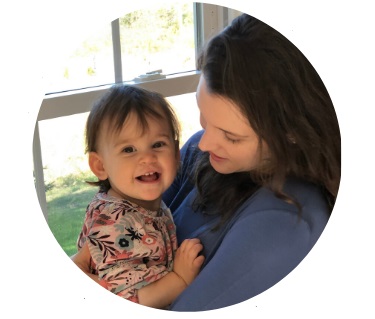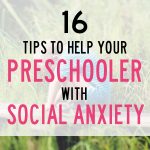
As a parent, I know what it feels like to be at a loss for how to help your child build social skills and make friends.
Here, I have outlined how to help your child (toddler, preschooler or elementary aged kid) enter play and make friends.
I focus on specific settings that are great for building social skills and confidence that you will want to take advantage of. I go into detail on three main skills you want to help your kid build to be successful at play. These skills continuously develop throughout all of childhood. Lastly, there is a secret to entering play already in progress, which is the most frequent type of play your child will come across.
Start with easy social settings to have positive experiences
I kept thinking I just needed my child to have more chances to interact with kids. So, I would bring her to places with lots of kids like a playground and say go play! But for a kid that is struggling socially, I now realize that this is like throwing a kid in the deep end of a swimming pool and saying go swim!
Instead, you want to focus on play in a comfortable environment, play in a structured setting, and one on one play. These are the easiest situations to have successful play giving your child space to build social skills. More importantly, this gives your child space to make stronger friendships that they might not be able to make in more complex settings.
The more times your child has a successful positive experience, the more confidence they will have about play and making friends. Each experience also builds their social skills so they can take on more complex social settings and play.
Play in a comfortable environment
The comfort of being in a familiar place really helps kids who have social anxiety. It also allows them to focus on the play instead of the new environment.
The best environments to have play happen are your home or a place your child frequents a lot. For instance, we go to a local kid museum all the time. So, in addition to having play dates at our house, we also do playdates at the museum.
Honestly, after I started paying attention to this, I was shocked at how much the location of a play date affected the success of the play date. We also try to always have the first playdate at our house and then the second at the other child’s house.
One on one playdate with a “success” starter and using the check in method:
One on one playdates are key to building social skills and a good friend. Studies show that by just having one good friend your child’s risk of getting bullied drops dramatically.
Additionally, by building the friendship through one on one playdates (an easier social setting than school), this friend can be your child’s helper in more complex social settings. When this friend enters play with others at school, they will bring your child along with them giving your child more opportunities to practice play that they might otherwise not have had.
Find a no-fail activity
For these one on one playdates to be successful, do them at your home first so your child is in a comfortable environment. The next key step is to start the play date off with a no-fail activity. It is best if you can find out what the other child really likes to do. For instance, if it is arts and craft, have a craft ready and set up for them to do at the beginning.
Not only will this set the mood, but also it will give your child instant success giving them confidence for the rest of the play date.
Use the check in method
Now that the playdate has started, make sure you step back. If the playdate turns into the three of you playing, then your child isn’t practicing play with friends. The best approach you can take during these play dates is to allow your child to do as much of the play date as possible by themselves.
The result will be that your child learns how to play with others and navigate conflict with friends when you aren’t there, such as at school. To build up to that, you want to be there only when you see they need help progressing through their playdate.
For example, after you set up that no fail activity, go find a book to read or something to do away from them but close enough to keep an eye on the situation and hear what is going on. If you see they have entered a conflict, then first wait and give them a chance to work it out. If they need help, then call your child over and give them some ideas on how to work it out. Then let your child go back by themselves and try again to work it out without you.
And if they are still having trouble, then it is time for you to help them out by either redirecting or changing the activity ,such as let’s take a break for a snack or problem solving with them.
An example here might be “I see you both want to be the pink princess. What are some solutions we could come up with? Maybe one of you gets to be the pink princess while you are at the restaurant and the other one gets to be the pink princess during the parade?” I find that usually kids love coming up with solutions if they don’t think they are being blamed or in trouble. By intervening at this point, you ensure the playdate can continue and is a success.
Add in more structured extracurriculars
Another way to build social skills are through structured activities. These give your child time with others, but these situations aren’t as intimidating as open play. Depending on the age of your child, this can be anything from story time to dance class or swim team.
Your child gets to be part of a team (or group) where social skills must be used. However, the social skills used during a structured setting are easier than open group play. It also gives kids something to bond over. It is a perfect middle ground and a great chance to make friends.
Also, these structured extracurriculars are becoming more important in children’s ability to build social skills because there are no screens or phones. Something that is becoming rare in today’s childhood.
I started my daughter in dance class at 3 years old and even that first year, I can’t tell you how much it has done for her social development and sense of confidence.
Focus on these three elements during play with you
Play changes as children get older. However, there are three key things a child must build in order to have successful play with other.
In fact, play is considered children’s work and now that I realize how important it is for social development, I believe that quote to be true. While playing with my child, I focus on certain things during play that will help my child play with others.
Focus on play that prioritizes people not toys.
I am very guilty of always picking out activities to do with my kids that are all about the toy. For instance, an art and craft project or building a tower together are great activities and build motor skills but they don’t help kids learn to play with others.
Social learning and play rely a lot on unspoken communication such as facial expressions, so children learn over time to check in with their play partner by looking at the other person to see what they are feeling. You can encourage this type of growth by picking activities that require joint attention.
This term, joint attention, essentially means to focus on something with another person (aka you have to play it together). An example is a board game where the fun comes from playing with others not from the toy itself.
Now, I try to pick activities that require joint attention because not only does it teach your child how to include other in their play but also because it teaches them to look at and talk to the other person. The more they look at the other person during play, the more unspoken communication they pick up on such as facial expressions.
What do these activities look like?
Any activity that requires a parent or another person. A great example is blowing up a balloon and then letting it fly all around. The child must include you because you have to blow up the balloon. It is fun to watch the balloon blow up and brings the child’s attention to your face. These types of activity teach kids that including others brings more fun than playing by themselves.
Additionally, by seeing the fun and excitement on your face, they see that you are also having fun. Eventually, this will translate into play with others by them checking in with their friend to see if they are also enjoying (or are bored) with the activity.
Another activity that is great is the zero-item pretend play. Make up a story line or act out your favorite book. Our two favorite pretend play games are restaurant and going on a trip. In either of these, I am the driver or the person at the restaurant. I make requests for things and then my kids go and get the imaginary item. I then am very silly about my responses. I can also include a lot of emotions in my responses using this game. I can be very upset about the food I got and pretend to throw it everywhere. I can be very sad that the water bottle I got was broken. Not only is the focus of this play the person but it is also about the other person’s responses and feelings.
Conflict resolution
You don’t want your child to never run into conflict. Originally, I liked to avoid kids who my child fought with or didn’t get along with. That was until I realized those were great chances to grow socially. In fact, you want your child to run into conflict. Conflict is great because they need to practice it. Just be careful to not solve their problems for them.
If you are always deciding or giving judgment on who needs to give the ball back etc., then they won’t learn how to solve their own problems. Eventually, this will catch up and those who can’t work their problems out with others will have a harder time socially.
Try to let your child always work out the problem themselves. If that ball gets taken from and you go get it back, then they have learned mom will get the ball for me. And when you do have to intervene, facilitate conflict resolution by stating the problem and then asking them what are some good solutions.
Additionally, practice conflict resolution through play. It never occurred to me that when I play with my kid, I shouldn’t let them always decide everything. In fact, by adding small conflict into play, I am giving them time to practice problem solving in a comfortable setting (aka with mom or dad).
From a very small age, you can start this by simply saying my turn (taking a turn) and then your turn (giving the toy back). When you have a toddler, your turn will be a few seconds but this idea of give and take is important to start. You don’t want one set of rules for when they play with you and another set of rules when they play with others.
As your child ages, you can introduce more complex conflict. For instance, if we are playing house, then I might decide my doll doesn’t want to attend the pony race. She wants to go to the mall. After this, I wait to see what my child decides to do. I let her work it out and pose some solutions. I try to pick situations she might encounter with another child and the more she practices with me the better she will get at it.
Empathy
Empathy is important in play because it allows children to be flexible. As they grow, they start to realize that others might feel different and have other interests than them. In play, empathy will be do what others want to play even though you really wanted to play something different. In play, empathy is also realizing what your friend is feeling and adjusting your play. To do this successfully, it relies on joint attention, which I talked about in learning to focus on the person and not just the objects of play.
So how do you teach empathy in play? First, playing baby is a great way. You take care of baby’s needs and see that baby is feeling all of these different things (tired, hungry, sad) but you aren’t. You also see how you can help baby with those needs even though they aren’t your needs.
Another way is to always be naming feelings of others around you. Help your child identify their feelings and observe other feelings. If someone trips and is crying, then you might say oh that child is sad because she fell and her knee hurts. Want to ask if she wants a band-aid or is okay?
When your child gets into a conflict with another kid, utilize that to teach that others might feel different. Explain the conflict through what each kid might be feeling during each part.
Kids who thrive socially have the ability to read other kids and adjust their play accordingly. They might go play ball because they understand that their friend(s) really wanted to do that.
Empathy is a muscle and the more you teach and practice it, the more it grows.
The secret to entering already in progress play
Picture a kid trying to enter a game of pretend. One kid comes up and grabs one of the toys so they can start to play also. The kids already in play will see this as that child taking their items they need for their play. They usually are not aware that the child wants to play as well especially if they have been very involved in their play.
The more successful route to enter play already in progress is when a child first observes the play and adds in a complement or shows value. For instance, if a kid tries to enter a game of pretend just like before with a complement such as wow, I love your necklace, what are you dressing up for? Or adds value such as look I found some great shoes that match your outfit! This will allow them to be integrated into the play.
Honestly, it is really amazing how kids who are very successful at play use this almost every time. Just start to observe and watch play happen in school, at a playground etc. The more you watch and observe, the better you can help your child.
For instance, if my child is having a hard time, then we will watch the play for a bit. I will then say something like oh wow those kids are building an ant house! Do you want to ask them if they want more sticks or leaves for their house? Or want to tell them their ant house is really cool?!? Here I am giving my child ideas on how to enter play.
Teach it by modeling it
If your child doesn’t want to approach kids by themselves, then that is okay. You can help them enter play by modeling it for them. Go with your child to talk to the kids already playing. You can complement their play and ask them questions. You could also find a role for you and your child to do in the play and then after your kid is more comfortable, take a step back.
By modeling how to enter play and talk to kids for your child, they will learn how to do it and eventually start to do it themselves.
Ask a better question
When a kid asks to play, they might say something like “do you want to play? or maybe “can I play too?” The problem with these questions is that it invites the answer no.
Instead teach your child to ask questions that are not yes/no. For instance, “what do you want to play?” or “what are you playing?” To get your child to use phrases like this more often, try to remind them to ask these questions. For instance, let’s say you see some kids play, you can say to your child, “go ask them what they are playing?” Or maybe you see one of your kid’s friends, you can say to your child, I see Sarah, go and ask her what she wants to play?
Other ways to help your child socially
Outside of adding in more play in easy settings, focusing on building social skills through play, with you and teaching the golden rule of entering play already in progress, here are a few more ways to help your child.
Read books about social
Reading books is a great mechanism for learning. Finding books that model social situations, feelings and play will help your child learn those skills. I like to stop and ask what characters are feeling or stop and talk about the conflict. I will ask my child what each character could do to find a good solution.
To find some great books, ask your librarian if they know of any for your child’s age. Additionally, be sure to check out this list I found.
Volunteer at the school during “open play”
If you can, try to volunteer at your child’s school. Ask to volunteer during a time when there is open play such as at recess or when they are in the classroom doing something that isn’t a structured setting (like storytime).
Your goal is to see how your child interacts with others. The first way this can help is to see who your child hangs out with or who tries to play with your child. These are the kids you need to have over for the one-on-one playdates to strengthen those friendships.
The other reason this can be so helpful is to see where your child is struggling most when it comes to social. Are they having a hard time entering play? Are they having a hard time being flexible in play? Do they get too focused on the object of play?
Remember your goal can not be to save your child from conflict but to understand what part of play is hard for your child. After that, you can use this guide and other resources to help your child build that missing skill.
Read Getting From Me to We
If you want to learn more on the topic, then I highly recommend you grab a copy of Getting from Me to We. It was game changing for us in helping our daughter make friends. I also use a lot of the lessons to also help my kids play together better.
It really taught me how children develop socially from infancy all the way through school. From this, I was then able to pinpoint where my child struggles and how to help. Most libraries should have a copy or could get it through intra-loan but if not, you can grab it off Amazon.
Pursue Making Friends Today
You can help your child succeed socially by working on play skills with you and finding opportunities to work on those socials skills with peers in easy comfortable settings. Focus your pretend play on building skills such as joint attention, conflict resolution, empathy and sharing.
Start by inviting kids over to your house for one on one play dates. Set up activities to ensure success. Also find ways for your kid to be with others in structured settings which are easier than the open play that happens at recess or on the playground.
Giving your child the chance to build these skills in safe comfortable settings will led to success and before you know it, your child will be a social butterfly.
If you found this post helpful, please share it on Pinterest or Facebook


I am a wife, teacher, and mother to two awesome girls. I write about what I am passionate about, which includes being a mom, house projects, beauty and skincare. I love to share my experiences, failures, and successes with my readers. Let this space be a resource for you to pursue your very best day.




